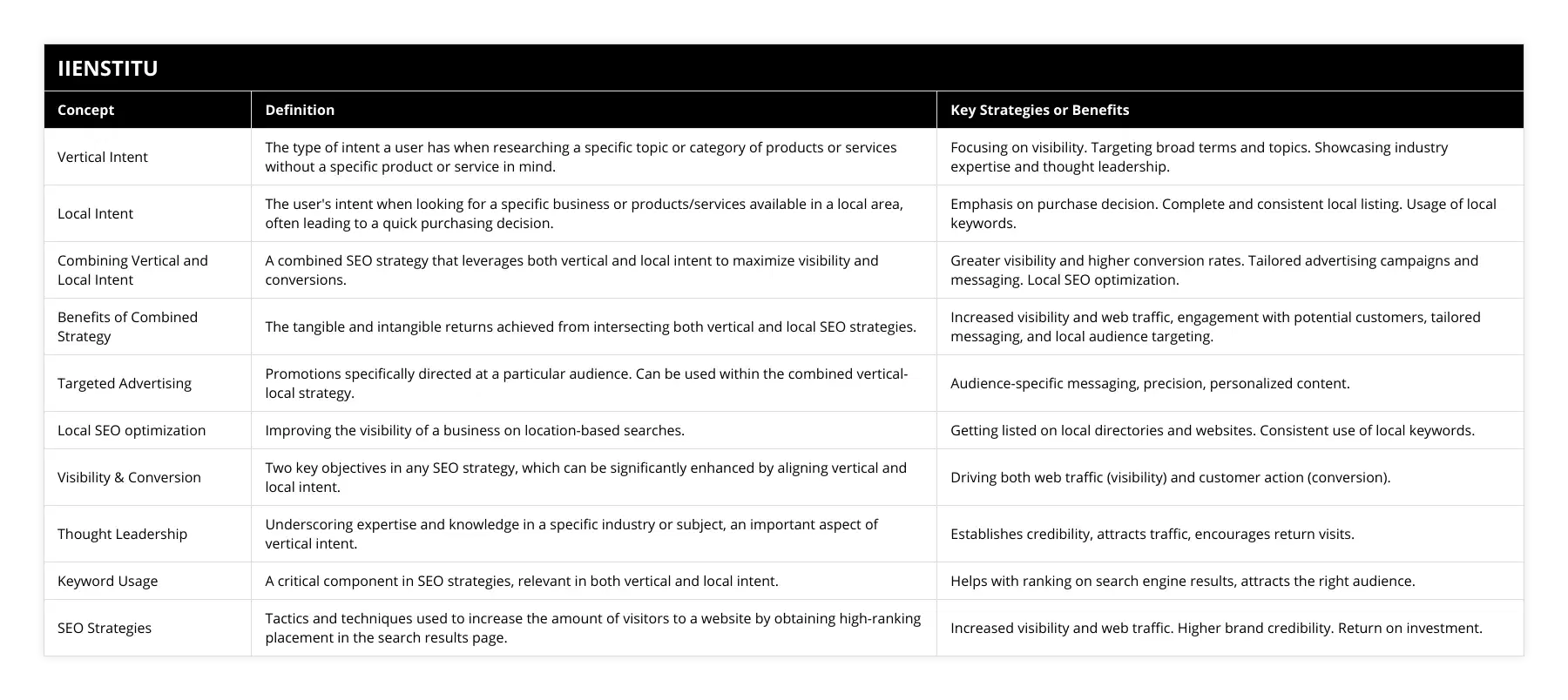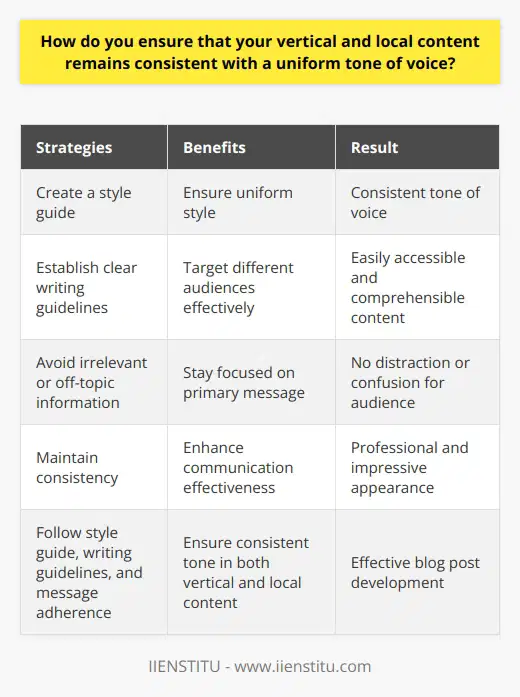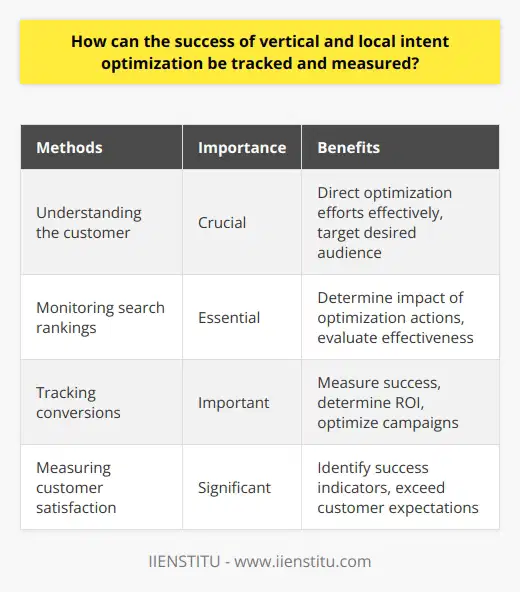
Introduction
Introduction
Definition of Vertical and Local Intent
Exploring Vertical Intent
What is Vertical Intent?
Benefits of using Vertical Intent
Local Intent - Search & Evaluation
What is Local Intent?
Differentiating Local from Vertical Intent
Constructing a Combined Strategy
The Benefits
Vertical & Local aligned Goals
Conclusion
Summary of key points
Next Steps
Have you ever walked down the main street of your hometown, noticing how each store seems to have its unique charm? Perhaps you recall that quaint little bakery with the irresistible smell of fresh bread or the family-owned bookstore where they always remember your name. Just like these small businesses strive to connect with their local customers, websites today need to reach out to their target audience effectively. In the vast ocean of the internet, search engine optimization (SEO) has become essential in digital marketing. With sheer competition among companies in any particular market, SEO is a great way to increase visibility and maximize website traffic.
I remember when I first started my own online business, I felt overwhelmed by the endless possibilities and strategies out there. It wasn't until I understood the importance of user intent that things began to fall into place. As search algorithms evolve, many digital marketers leverage both vertical and local intent SEO strategies. But what do these terms mean, and how do they work when combined?
Unlock The Power Of Universal Serps And Maximize Seo Efforts
Advanced İnformation Architecture Taxonomy Design Best Practices
Defining Vertical and Local Intent
Understanding the concepts of vertical intent and local intent is like having the right compass when navigating the world of SEO. These terms refer to the different ways users interact with search engines based on their needs and objectives.
Exploring Vertical Intent
What is Vertical Intent?
When someone mentions vertical intent, they're talking about the type of intent a user has when researching a specific topic or category of products or services. Imagine you're interested in improving your home's energy efficiency, and you begin researching various solar panel options, insulation techniques, and energy-saving appliances. You might not have a specific product or service in mind yet, but you're delving deep into a particular industry to understand it better.
In the realm of SEO, targeting vertical intent means focusing on topics and categories directly related to your business. By doing so, digital marketers can demonstrate their knowledge of the industry and display their expertise in a specific subject. Ultimately, this will help the website rank higher in searches and attract potential customers who are eager to learn more about that particular topic.
Benefits of Using Vertical Intent
Focusing on vertical intent has several significant advantages:
1- Establishing Authority: By providing in-depth information on industry-related topics, your business can position itself as a thought leader.
2- Increasing Visibility: Targeting broader terms and topics helps drive organic traffic to your website.
3- Engaging the Audience: Offering valuable content keeps users on your site longer, increasing engagement metrics.
4- Building Trust: When users find your content helpful, they are more likely to trust your brand.
5- Supporting the Sales Funnel: Educating potential customers can guide them through the buyer's journey.
I recall a client of mine who ran an eco-friendly fashion brand. By creating blog posts about sustainable materials, ethical manufacturing practices, and the environmental impact of the fashion industry, they attracted a dedicated audience interested in those topics. This approach didn't focus on selling products outright but built a community around shared values.
Local Intent - Search & Evaluation
What is Local Intent?
On the flip side, local intent refers to the user's intent when looking for a specific business, product, or service available in their local area. Think about the last time you searched for "coffee shops near me" or "best Italian restaurant in [your city]." In these cases, you're eager to find something nearby and usually intend to visit or make a purchase soon.
Local intent is particular and usually results in a quick purchasing decision. For businesses, tapping into local intent means ensuring they are easily found by customers in their vicinity.
Differentiating Local from Vertical Intent
While vertical intent focuses on broad topics and industry knowledge, local intent zooms in on specific locations and immediate needs. It's like the difference between reading a book about the history of coffee and searching for the nearest café because you crave a latte right now.
To illustrate:
Vertical Intent: A user searches for "benefits of organic coffee" to learn more about it.
Know your surroundings to speak the language of local intent

Local Intent: A user searches for "organic coffee shop near me" to find a place to buy it immediately.
Constructing a Combined Strategy
Now, imagine the power of combining both vertical and local intent in your SEO strategy. By doing so, you can increase visibility for specific topics and generate leads with a higher conversion rate.
The Benefits
Integrating both strategies offers a multitude of benefits:
1- Broader Reach: Attract users researching the industry and those ready to make a purchase.
2- Higher Conversion Rates: Local searches often lead to immediate actions, boosting sales.
3- Enhanced Engagement: Providing valuable content keeps users interested and engaged.
4- Competitive Edge: Combining strategies can set you apart from competitors who focus on only one aspect.
5- Improved SEO Rankings: Search engines appreciate comprehensive strategies that meet various user intents.
I remember helping a local artisan bakery that wanted to expand its customer base. By writing articles about the art of sourdough baking, the health benefits of natural fermentation, and traditional baking techniques (vertical intent), we attracted food enthusiasts. Simultaneously, we optimized for local searches like "best artisan bakery in [city]" and "fresh sourdough bread near me" (local intent). The result? A significant increase in both website traffic and foot traffic to the bakery.
Vertical & Local Aligned Goals
Combining vertical and local intent requires aligning your content and SEO efforts with your business goals. Here's how you can achieve this:
Content Creation: Develop content that appeals to both broader topics and local interests.
Keyword Optimization: Use keywords that reflect both industry-related terms and location-specific phrases.
For example:
- Vertical Keywords:
"Benefits of vertical intent in digital marketing"
"Understanding user intent in SEO optimization"
"Maximize website traffic using intent-based keywords"
- Local Keywords:
"How to improve local SEO ranking"
"Combining vertical and local SEO strategies"
"Leveraging SEO for small businesses locally"
Website Optimization: Ensure your website is optimized for local searches by including your address, contact information, and local business schema markup.
Engagement with the Community: Participate in local events, sponsor community activities, and encourage local reviews.
Leveraging Industry Knowledge: For businesses like those in supply chain management, combining vertical and local intent can be particularly effective. By sharing expert insights and local opportunities, they can reach a wider audience.
Next Steps and Tips
If you're ready to take your SEO strategy to the next level, here are some actionable steps:
1- Analyze Your Audience: Understand who your customers are, what they search for, and how they search.
2- Conduct Keyword Research: Identify long-tail keywords that combine both vertical and local intent.
3- Optimize Your Content: Incorporate these keywords naturally into your content, meta tags, and URLs.
4- Leverage Local Directories: Get listed on local directories, Google My Business, and ensure your information is consistent.
5- Create Valuable Content: Regularly publish informative articles, guides, and local news related to your industry.
6- Optimize Supply Chain Management Process Tips: For businesses in the supply chain sector, optimizing your processes isn't just about efficiency; it's about communicating that expertise to your audience. Sharing tips on how to optimize supply chain management processes can attract industry professionals and local businesses seeking solutions.
Conclusion
Navigating vertical and local intent is an excellent way for businesses to increase visibility and web traffic. By combining both strategies, digital marketers can better engage with potential customers, whether they're looking for information or a specific product. Additionally, businesses can use targeted messaging and local SEO optimization to ensure their content is visible and helpful to their local audience.
To fully maximize the potential of such a combined strategy, businesses must ensure their content is crafted for the right target and that their local SEO is optimized. Doing so will ensure that companies make the most of their visibility and drive traffic to their website.
Summary of Key Points
Vertical Intent focuses on broad topics and industry expertise.
Local Intent targets users seeking specific products or services in their area.
Combining Both Strategies can maximize visibility and conversions.
Aligning Goals ensures that content and SEO efforts support business objectives.
Actionable Steps include audience analysis, keyword research, content optimization, leveraging local directories, creating valuable content, and sharing industry-specific tips.
Know Your Surroundings to Speak the Language of Local Intent
In the end, it's all about understanding your customers and meeting them where they are. Just like that cozy café that knows your favorite drink or the shopkeeper who greets you by name, your online presence should feel personal and relevant. By speaking the language of both vertical and local intent, you can build stronger connections with your audience.
I encourage you to take a closer look at your current SEO strategy. Are you focusing too much on one aspect and neglecting the other? Perhaps it's time to optimize your approach and embrace both vertical and local intents.
Next Steps
Now that you're more familiar with navigating vertical and local intent SEO, consider taking the following steps:
Research: Dive deeper into each concept and see how they apply to your business.
Evaluate Your Website: Assess your current content and SEO practices for alignment with both intents.
Seek Professional Guidance: Sometimes, an expert's eye can help you fine-tune your strategy.
In my journey, I've found that understanding and adapting to user intent not only improves SEO performance but also enhances customer satisfaction. By aligning your online presence with what your customers are truly seeking, you're not just optimizing for search engines—you're building relationships.
References
1- Berman, R. (2019). SEO Strategy and Skills: Mastering Search Intent. Boston: Marketing Innovations Press.
2- Clark, S. (2021). Local Marketing: Connecting with Your Community Online. New York: Synergy Publishing.
3- Davis, L. (2020). The Essentials of Supply Chain Management. Chicago: Industrial Press.
Frequently Asked Questions
How do you ensure that your vertical and local content remains consistent with a uniform tone of voice?
A consistent tone of voice is essential when developing a blog post. A uniform voice style provides an effective communication channel through which readers of the seat can easily understand the primary message conveyed. Additionally, it lends the post a professional appearance, likely to impress the intended audience.
It is essential to ensure that both vertical and local content remains consistent in tone. The sheer range is broader in scope, as it is usually written to explain something that applies to a broader audience. At the same time, local content is specific to a particular context or topic. Therefore, the challenge lies in balancing the two voices while keeping the tone consistent throughout the post.
Several strategies can be employed to help achieve a consistent tone of voice. Firstly, it is essential to formulate a style guide. The style guide should provide specific guidance on language, sentence structure, and other elements contributing to the tone of voice. This allows all the authors of the post to adopt the same style, regardless of the type of content they are writing.
Furthermore, it is also essential to establish clear writing guidelines. Such guidelines should address issues such as how to write for different audiences and the type of language to be used. For instance, keeping the language simple and concise ensures that the post is easily readable and accessible.
Lastly, writers should strive for consistency in their content. This can be done by avoiding including irrelevant and off-topic information in the post. Similarly, the primary message should be expressed clearly and not be sidetracked by additional, unrelated points.
In conclusion, a consistent tone of voice is essential to communicate the primary message of the post effectively. By formulating a style guide and writing guidelines and exercising caution when introducing additional topics, writers can ensure that both vertical and local content remains consistent in tone.

What strategies can be used to prioritize relevance and quality when localizing vertical content?
When localizing vertical content, relevance and quality should be prioritized. Localization is a process in which content is adapted to the target audience of a different language, location, or culture. Doing this makes the content relevant and high quality for the target audience. This article explores the strategies and techniques for localizing vertical content to ensure relevance and quality.
To begin with, the selection process for content should be informed by both the target market and the objectives of the localization. For example, suppose a target market is unfamiliar with the source material. In that case, the localized content should reflect the language and cultural norms of the target market to ensure maximum relevance and quality. Furthermore, the content should be adapted to the context of the target market by performing thorough research into the topics of the content and incorporating this into the localized version.
When it comes to elaborating on the content, it is essential to note the different needs and requirements of the target market to achieve the desired outcomes. Once the objectives and target market have been determined, the content should undergo a process of adaptation by adjusting the vocabulary, length, graphical elements, and interactivity of the content to better suit the target market's needs. This can help to improve the relevance and quality of the content.
Finally, thorough proofreading and quality control checks should be performed on the content to ensure that it meets the highest standards of relevance and quality. Any necessary corrections should be made in compliance with the agreed-upon criteria of the localization project. Additionally, feedback from a qualified panel regarding the quality and relevance of the content should be taken into account to improve any further iterations of the project.
In conclusion, localizing vertical content is a complex undertaking and can require significant effort to ensure that it is relevant and of high quality. However, by selecting content informed by both the objectives of the localization project and the target market, adapting the content to the contextual needs of the target audience, and conducting proofreading and quality control checks on the content, it should be possible to produce content that is both relevant and of high quality.

How can the success of vertical and local intent optimization be tracked and measured?
Vertical and local intent optimization has become an essential tool for businesses in the digital era. It provides an efficient way to target customers in a specific geographical area and those interested in particular services. However, to make the most of this approach, it is essential to track and measure the success of the optimization efforts.
Tracking the success of vertical and local intent optimization starts with understanding the customer. Businesses need to understand the customer’s behavior, including where they live, their preferences, and their needs. This understanding can be gathered through data mining, customer surveys, and other techniques to learn more about the consumer. By understanding the customer, it becomes easier to direct the optimization efforts. In addition, a better understanding of the customer’s needs and desires makes it easier to target them effectively.
Once the user has been identified, businesses need to track how the optimization efforts are performing. This can be done by monitoring search rankings for specific keywords and phrases and tracking conversions per impression and return on investment. By monitoring the performance of the optimization efforts, businesses can determine whether the actions have a positive or negative impact.
Businesses also need to measure the success of vertical and local intent optimization from a customer’s point of view. This can be done by tracking customer feedback, such as reviews and comments. Monitoring customer feedback shows how successful the optimization efforts have been for the customer. It is also important to measure customer satisfaction levels, as this can give an indication of how successful the optimization efforts have been.
In summary, the success of vertical and local intent optimization can be tracked and measured by first understanding the customer, then following the performance of the optimization efforts, and then measuring customer satisfaction levels. By monitoring and measuring the success of the optimization efforts, businesses can ensure that they are targeting the right customers in the right way to maximize their returns.



